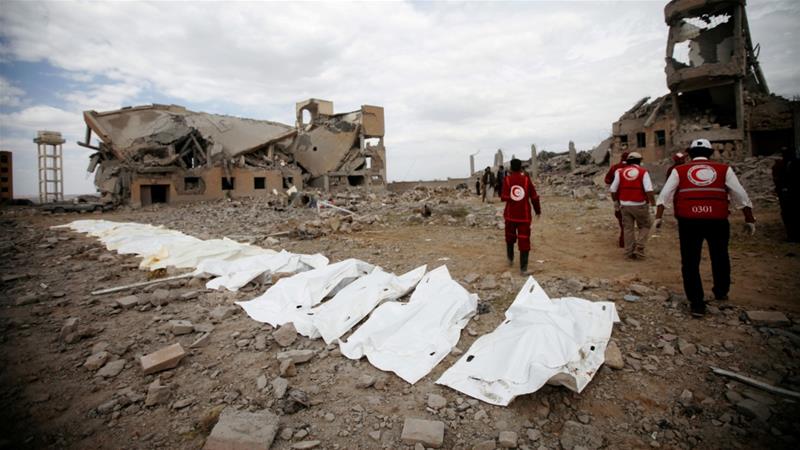Home » World News »
US-made bomb used in deadly Saudi-led air raid in Yemen
The ordnance, made by US company Raytheon, killed six people including three children in an air raid in June.
The Saudi-led coalition in Yemen used precision-guided munition made by the United States in a June air strike that killed six people including children, a new report by Amnesty International said.
The rights group analysed photographs of the remnants of the missile attack, concluding the munition that hit a residential building was a US-made 500 pound (230kg) GBU-12 Paveway II.
The bomb, dropped on June 28 in Taiz province, was made by US-based defence company Raytheon, according to Amnesty.
“It is unfathomable and unconscionable that the USA continues to feed the conveyor belt of arms flowing into Yemen’s devastating conflict,” said Rasha Mohamed, Amnesty’s Yemen researcher.
“Despite the slew of evidence that the Saudi and Emirati-led coalition has time and again committed serious violations of international law, including possible war crimes, the USA and other arms-supplying countries such as the UK and France remain unmoved by the pain and chaos their arms are wreaking on the civilian population.”
Among the six civilians killed in the attack, which took place in Warzan village in the directorate of Khadir, were a 52-year-old woman and three children, aged 12, nine and six.
The human rights organisation said in the report the closest possible military target at the time of the attack was a Houthi rebel operations room about 1km away.
However, that location was not being used after being struck by several coalition air strikes in 2016 and 2017, Amnesty said.
Witnesses told the organisation there were no fighters or military objectives in the vicinity of the house at the time of the attack.
Shortly after the initial explosion, a second strike hit the location.
The home was struck again five days later while family members were at the house inspecting the site. No one was hurt in the second attack.
Rasha Mohamed, Amnesty International’s Yemen researcher
“Intentionally directing attacks against civilians or civilian objects, disproportionate attacks and indiscriminate attacks that kill or injure civilians are war crimes,” Mohamed said.
“Arms-supplying states cannot bury their heads in the sand and pretend they do not know of the risks associated with arms transfers to parties to this conflict who have been systematically violating international humanitarian law.”
Amnesty also spoke to victims’ family members who dug out some of the missile parts that lead to the identification of the American weapon.
“I was around three minutes’ walk away working at a neighbouring farm. I heard the plane hovering and I saw the bomb as it dropped towards the house. I was next to the house when the second bomb fell… and I got down onto the ground,” one eyewitness said.
Another person told Amnesty they buried the victims the same day “because they had turned into severed limbs”.
“There were no corpses left to examine. The flesh of this person was mixed with that person. They were wrapped up [with blankets] and taken away,” the eyewitness said.
Tens of thousands of people, mostly civilians, have been killed in Yemen since Saudi Arabia and its allies intervened in March 2015 in support of the beleaguered government. President Abd-Rabbu Mansour Hadi’s government was ousted by the Houthis from Sanaa in late 2014.
The fighting has also displaced millions and left 24.1 million – more than two-thirds of the population – in need of aid.
The United Nations has described Yemen as the world’s worst humanitarian crisis.
Inside Story
The growing human cost of the war in Yemen
Source: Read Full Article




